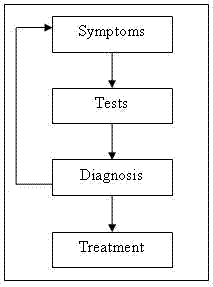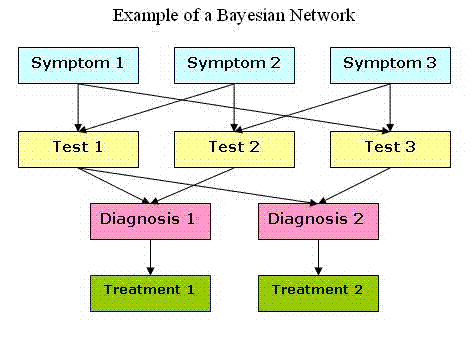Statistical Medical Diagnosis
From DDL Wiki
Misdiagnois is a large problem in todays health care system with some studies have reporteing misdiagnosis errors as high as 40%. As the medical field gets more complicated, more and more cases are referred to specialists, often, wasting precious time for the patient waiting for an appointment with these specialists. To combat this growing problem, many researchers have turned to a statistical method for medical diagnosis. Using statistical models, researchers hope to create software capable of taking the symptoms of a patient and returning the most probably diagnosis. This technique can also be used in intermediate stages to help physicians determine what tests to perform or what other symptoms to look for. There are many different statistical models used for different problems.
Contents |
Standard Diagnosis
Physicians diagnose patients by first recording their symptoms. These symptoms usually indicate the types of tests that need to be performed. The results of these tests and the symptoms are used to find a diagnosis. The diagnosis is then usually used to go look for symptoms that may not have presented themselves at first examination. If a sufficient number of symptoms can be found to mach the diagnosis, the diagnosis is considered correct.
The problem with this technique is it relies heavily on subjective parameters such as time and relative expertise. It also is subject to a high degree of randomness, as some symptoms will show while others do not. Some symptoms may show at strange times or in unusual places. Furthermore, many diagnoses have very similar symptoms. Although software will never truly eliminate the need for a physician, diagnostic tools can help the physician know what to look for and where and when to look for it.
Symptoms
Symptoms are the observable characteristics of the patient. This may include both visual and self reported events. Symptoms are time dependent and can contain levels. A fever or rash can be characterized from less severe to more severe. An error term is present in this category as self reported symptoms are likely to be used. A good example is pain. Someone in a lot of pain may tell the physician that it feels like 10 out of 10. However, that person may not have the experience to know what a 10 might be. On an individual basis this does not cause any problems, but when used comparatively, it may cause errors.
Tests
Diagnostic tests are used to determine the unobservable characteristics of a patient. This may include blood work, CT scans, MRI's, and other tests. The results of these tests also contain levels as well as some level of uncertainty, as false positives or incorrect negatives will skew the results.
Diagnosis
As discussed above, the diagnosis may be full of error. this is not only dependent on the previous error, but also the error in judgment forma physician, who may not have seen a certain illness or who may have limited experience.
Treatment
Treatment is only administered if the diagnosis is confirmed. An improper treatment can lead to causing even more trouble then help. It is the improper treatments that result from misdiagnosis that cause the most injury and each to patients.
Probability Theory
Probability theory is a mathematical study of events that involve some level of randomness. It is commonly separated into two categories, Frequentists and Bayesians. Frequentists will only consider events that are random and have been shown in experimental or theoretical experiments. Bayesians will consider any situation which can logically be true. For example, a Bayesian will consider the possibility of life on other planets, while a Frequentist will not consider this possibility as it has never been shown. Frequentist techniques cannot be used to handle medical diagnosis as they cannot deal with the unknown.
Bayesian Networks
Bayesian Networks are used for less complicated diagnosis models. A Bayesian network is a probability flow chart, where each node represents a possibility and each arc connecting the nodes represents a probability function. Each sub node is then dependent on both the probability function and its parents. The nodes in these networks can begin as symptoms, and through the probability functions, end at diagnosis. Each step along the way is supposed to simulate the process.
Bayesian networks are commonly used because of their ability to predict an outcome form unknown environmental properties. The common example is the wet lawn. Bayesian networks are used to predict if the wet lawn is due to rain or a sprinkler when the true cause is unknown.
Below is an example Bayesian network. It shows how symptoms may lead to tests which will lead to a diagnosis and eventually treatment.
Fuzzy Logic
More complicated medical situations cannot be described with only Bayesian networks. This is usually the case when many conditions may be affecting a person at the same time. In this case, fuzzy logic is used to help define quasi states. The difference between fuzzy logic and probability is often overlooked. A good example is a coin flip. Probability would say that there is a 50 percent chance that it will land heads and a 50 percent chance that it will land tails. However, it could only ever be heads or tails. Fuzzy logic would allow for the coin to be some part heads and some part tails at the same time.
In medical diagnosis, this is required as medical conditions rarely fall into one category. Fuzzy logic allows for levels of truth. In a Bayesian network, the possibility of a having a fever is true or false, where each possibility has its own likelihood, but only one outcome can exist at one time. Fuzzy logic allows for part truths, such as a mild fever or sever fever. This concept is extended to all but the basic symptoms.
Fuzzy logic also allows for the diagnosis of multiple conditions. A grouping of symptoms may cause one condition, which in turn will cause another, which may change the original symptoms. This complexity can usually only be handled by an experienced physician. Fuzzy logic allows for these possibilities and may be able to predict several conditions at once.
The process of fuzzy logic is performed by Artificial Neural Networks (ANN). This type of data set analysis is on the cutting edge of Artificial intelligence research. A neural network simulates the complexity of the human brain and attempts to use the same techniques humans use to process information. This technique works so well because it does not only try to find linkages between the characteristics of the patient, but it attempts to follow the same path a physician would follow when diagnosing a patient. ANN's allow for the acceptance of uncertainty as well as an important learning technique. Bayesian networks are static, and must be reworked when new information is available. ANN's are dynamci and are able to apply lessons from previous data to new data. The drawback of neural networks is they cannot be programmed to perform a specific task. Their inherent learning ability means that they must be given examples before they can begin to solve actual problems. This means that in the complexity of medical diagnosis, the examples given to an ANN must be carefully selected.
Studies have shown that ANN methods of medical diagnosis very often outperform Bayesian network techniques.
Conclusion
Medical diagnoses will continue to get more difficult with each advancement in medicine. Each step in the diagnosis procedure contains a significant amount of error. This error will continue to lead to mistakes made by physicians. To cope with this difficulty, statistical medical diagnostic tools can help physicians and health care workers eliminate the mistakes in diagnoses that plague the healthcare system.
References
[1] Armitage, P., Berry, G. and Matthews, J. (2002). Statistical Methods in Medical Research, 4th edition.
[2] Sargent, Daniel. (2001). Comparison of Artifical Nerual Networks wiht Other Statistical Approaches, Conference on Prognostic Factors and Staging in Cancer Managment.
[3] Kononenko, Igor. Inductive and Bayesian Learnign in Medical Diagnosis.
[4] Matthews, D. and Farewell, V. (1996). Using and understanding Medical Statistics, 3rd Edition. Karger Publishers.


